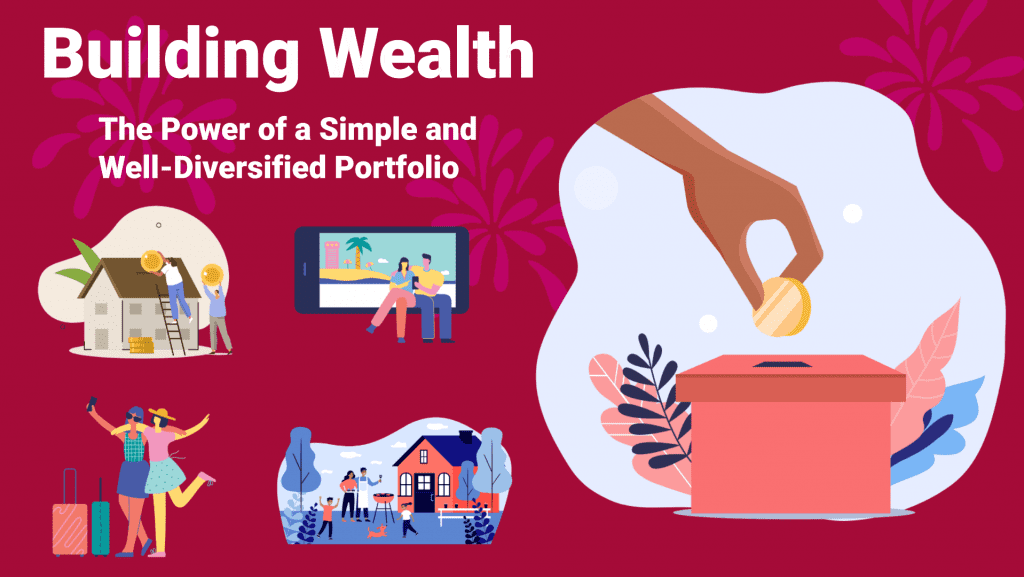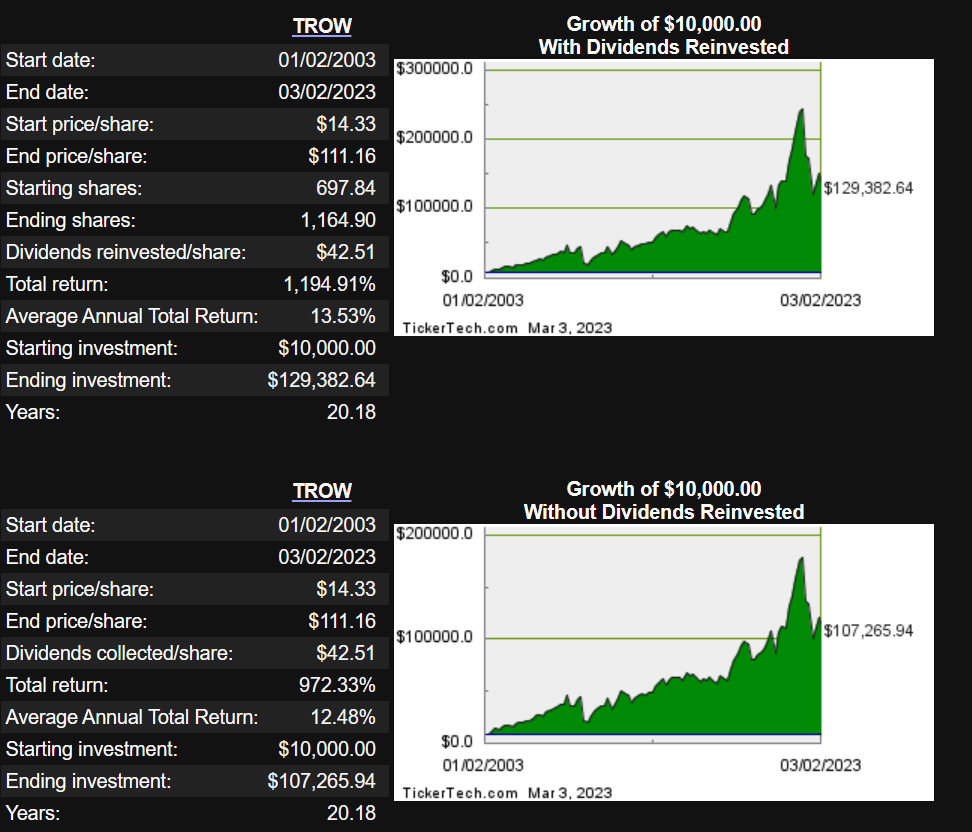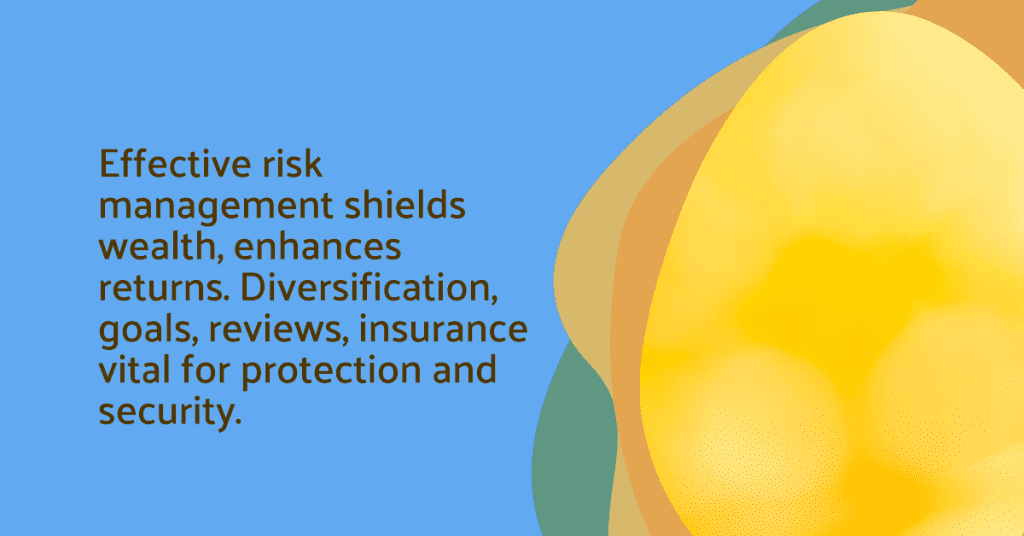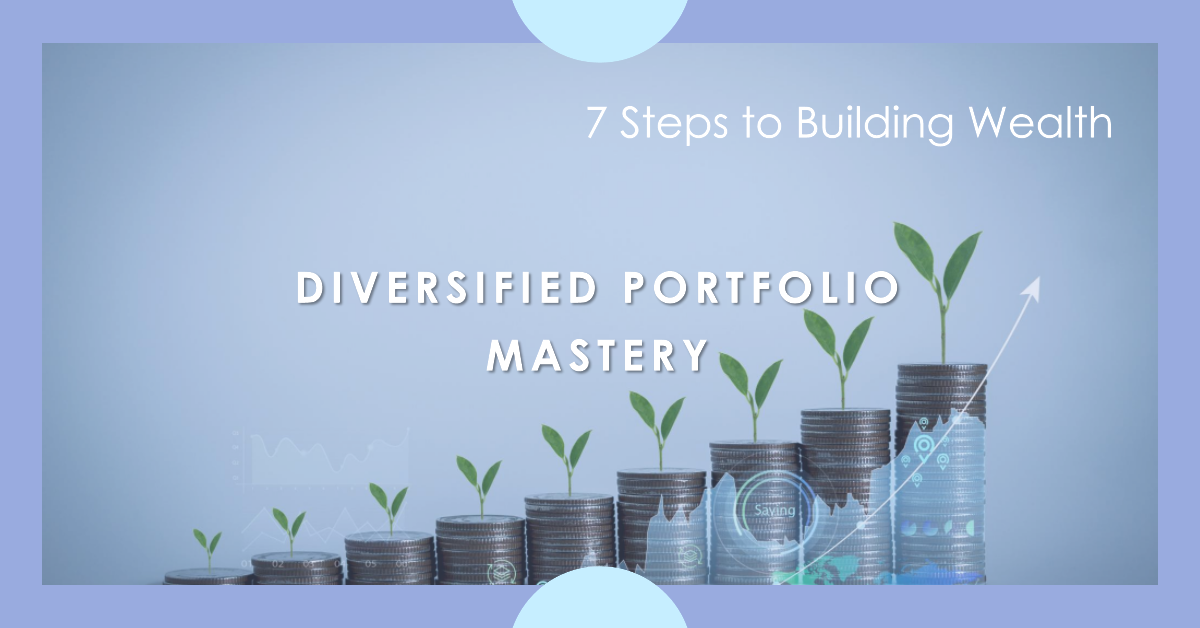Table of Contents
Introduction to building wealth with a well-diversified portfolio

Building wealth is a goal that many individuals aspire to achieve. While there are various strategies and approaches to wealth accumulation, one proven method is through a well-diversified portfolio. A portfolio is a collection of investments, such as stocks, bonds, and real estate, that helps individuals grow their wealth over time. In this article, we will explore the power of a simple and well-diversified portfolio in building long-term wealth.
Understanding the power of simplicity in portfolio management
When it comes to portfolio management, simplicity is key. Many investors are tempted to complicate their portfolios by adding numerous investments in an attempt to maximize returns. However, this approach often leads to unnecessary complexity and increased risk. A simple portfolio, on the other hand, allows investors to focus on the essentials and make informed decisions based on their financial goals.
By keeping a portfolio simple, investors can better understand and monitor their investments. This enables them to react promptly to market changes and make adjustments when necessary. Additionally, a simple portfolio reduces the administrative burden associated with managing a complex portfolio. This frees up time and resources that can be better utilized for other wealth-building activities.
The benefits of diversification in wealth building
One of the fundamental principles of portfolio management is diversification. Diversification involves spreading investments across different asset classes, sectors, and geographic regions to reduce risk. By diversifying your portfolio, you are not putting all your eggs in one basket and are better protected against market volatility.
Diversification offers several benefits in wealth building. Firstly, it helps to minimize the impact of any single investment or sector on your overall portfolio performance. If one investment underperforms, the impact on your portfolio will be mitigated by the performance of other investments. Secondly, diversification provides exposure to a wide range of potential growth opportunities. By investing in different asset classes and regions, you can take advantage of various market cycles and capitalize on emerging trends.
Common misconceptions about diversification
Despite its benefits, diversification is often misunderstood. One common misconception is that diversification guarantees positive returns and eliminates all investment risk. While diversification can reduce risk, it does not eliminate it entirely. Investments are still subject to market fluctuations and other external factors that can impact their performance.
Another misconception is that diversification requires a large amount of capital. In reality, diversification can be achieved with investments of any size. It is more about spreading your investments across different assets rather than the total amount invested. Even small investors can benefit from diversification by allocating their funds across a mix of stocks, bonds, and other investment vehicles.
Key elements of a well-diversified portfolio
A well-diversified portfolio consists of several key elements. Firstly, it includes a mix of different asset classes, such as stocks, bonds, and cash equivalents. Each asset class has its own risk and return characteristics, and by combining them, you can achieve a balanced and diversified portfolio.
Secondly, a well-diversified portfolio includes investments across various sectors and industries. This ensures that your portfolio is not overly concentrated in a single sector, which can be risky if that sector experiences a downturn. By spreading your investments across different sectors, you can reduce the impact of any one sector on your overall portfolio performance.
Lastly, a well-diversified portfolio considers geographic diversification. Investing in different regions allows you to take advantage of global economic growth and reduces the risk associated with being too heavily invested in a single country or region.
How to create a simple and well-diversified portfolio

Creating a simple and well-diversified portfolio involves a systematic approach. Firstly, you need to determine your investment goals and risk tolerance. This will help you identify the appropriate asset allocation for your portfolio. Generally, younger investors with a longer time horizon can afford to take on more risk and allocate a higher percentage of their portfolio to stocks. On the other hand, older investors who are closer to retirement may opt for a more conservative allocation with a higher proportion of bonds and cash equivalents.
Once you have determined your asset allocation, you can select individual investments within each asset class. It is important to conduct thorough research and analysis to ensure that your investments align with your financial goals and risk tolerance. Consider factors such as historical performance, management expertise, and the overall outlook for the investment.
Regularly monitor your portfolio and make adjustments as needed. Rebalancing your portfolio periodically will ensure that your asset allocation remains aligned with your investment goals. Additionally, stay informed about market trends and economic indicators that may impact your investments. This will enable you to make informed decisions and take advantage of opportunities as they arise.
And Exactly What Do Stocks That Pay Dividends Mean?
Dividend stocks are those that pay investors dividends on a regular basis. These companies often have stable profits and a long-term commitment to dividend payments. For example, stockholders of Apple (AAPL) presently get a quarterly dividend payment of $0.23 per share. That works out to $23 for every 100 shares of Apple stock owned each quarter.
So, Apple is a dividend stock, albeit not a high-yield dividend stock. With a dividend payout of $0.23 per share per quarter, the dividend yield is a meager 0.61% per annum. Therefore, long-term capital gains are the primary focus for Apple stockholders.
What Stock Pays the Highest Dividend?
Some of the most popular high-yield dividend stocks right now include Altria Group (MO), Verizon Communications Inc. (VZ), and Ares Capital Corporation (ARCC). See how their dividend yields compare to one another so that you can make an informed decision.
| Stock Symbol | Name | Price | Dividend | Dividend Yield |
|---|---|---|---|---|
| MO | Altria Group Inc | 46.53 | 3.76 | 8.15% |
| ET | Energy Transfer LP Unit | 13.05 | 1.22 | 9.54% |
| ARCC | Ares Capital Corporation | 19.45 | 1.92 | 9.92% |
| ABR | Arbor Realty Trust Inc | 15.07 | 1.6 | 10.67% |
| SU | Suncor Energy Inc. | 35.3 | 1.56 | 4.54% |
| TD | Toronto-Dominion Bank | 65.49 | 2.87 | 4.31% |
| JNJ | Johnson & Johnson | 154.02 | 4.52 | 2.96% |
| VZ | Verizon Communications Inc. | 38.26 | 2.61 | 6.81% |
Exactly How Do Stocks That Pay Dividends Work?
To get dividends, you need to be the owner of shares in the company through a brokerage account or retirement plan like an IRA or 401(K). Dividends are payments made to stockholders by a firm out of a percentage of its profits. Dividends are an established and recurring income stream for company stockholders. You won’t have to do anything to get your dividends deposited into your account when they’re paid.
For instance, I have 1,000 shares of Suncor Energy Inc. (SU) stock in my portfolio. The dividend per share is $0.38 per quarter. On the dividend payment day, my brokerage account will be automatically credited with $380. As I received dividends, I put the money toward purchasing more shares of Suncor Energy Inc. (SU). Let’s keep this simple and say that $38 is the current price of SU stock per share. That’s an additional 10 shares. ($380 ÷ $38 = 10). Now I have 1,010 shares. In the next quarter, I will receive a dividend payment of $383.80. (1010 x $0.38 = $383.80).
Tips for Buying Dividend Stocks
Dividend Growth
Investing in stocks that pay dividends requires little effort. But you should take your time and do your homework. There are a few things to remember. Prior to anything else, you should check for a track record of dividend increases. Constant dividend growth is a leading economic indicator of a financially sound company.
Dividend Payout Ratio
Second, try to choose companies that have a payout ratio that is not too high. A lower dividend payout percentage indicates that the company is keeping some of its profits for growth and is therefore less likely to cut dividends in the future. On the other hand, too high a payout ratio might be detrimental to a company’s long-term sustainability.
Yield on Dividends
Finally, check the dividend yield to see if it is currently acceptable. A decent rule of thumb is to look for dividends yielding at least as much as the current 10-year Treasury. Twice that much may be a warning sign. An abnormally high dividend can have a significant impact on a business’s bottom line.
Dividend Reinvestment Plans (DRIPs): How to Grow Your Investment Portfolio
Increasing Wealth via Investing and Compounding Dividends
Dividends compound if you reinvest them in the company by purchasing additional shares and then reinvesting the dividends from those shares. As a result, an investor’s wealth grows exponentially over time if the dividends they receive are reinvested in the market to buy more shares. When compared to taking the dividend income and putting it in your pocket, this strategy will yield greater returns over time.
See the working example below. By now, you would have over $129,000 if you had invested $10,000 in T. Rowe Price (TROW) in 2003 and kept reinvesting your dividends. In contrast, if you did not reinvest the dividends, your total would be $22,000 lower.

Strategies for managing and monitoring your portfolio
Managing and monitoring your portfolio is an ongoing process. Here are some strategies to help you effectively manage your investments:
- Set clear investment goals: Define your financial objectives and time horizon. This will guide your investment decisions and help you stay focused on your long-term goals.
- Regularly review your portfolio: Conduct periodic reviews of your portfolio to assess its performance and ensure that it remains aligned with your investment goals. Consider rebalancing if your asset allocation has drifted significantly from your target.
- Stay informed: Keep up-to-date with market news, economic indicators, and industry trends. This will help you make informed decisions and stay ahead of potential risks or opportunities.
- Seek professional advice if needed: If you are unsure about managing your portfolio or need guidance on complex investment strategies, consider consulting a financial advisor. They can provide personalized advice based on your specific financial situation and goals.
The role of risk management in wealth building

Risk management is a critical aspect of wealth building. While investing involves some level of risk, effective risk management can help protect your wealth and improve your long-term returns. Diversification is one key risk management strategy, as mentioned earlier. By spreading your investments across different assets, sectors, and regions, you can reduce the impact of individual investment losses on your overall portfolio.
Another risk management strategy is setting clear investment goals and regularly reviewing your portfolio. By defining your investment objectives and periodically assessing your portfolio’s performance, you can identify and address any potential risks or underperforming investments. Additionally, maintaining an emergency fund can provide a safety net during times of financial hardship or unexpected expenses.
It is also important to consider the role of insurance in risk management. Adequate insurance coverage, such as health insurance, life insurance, and property insurance, can protect your assets and provide financial security for you and your family.
Avoiding Attempts to Predict Market Movement
Investing in stocks is a good option for beginners because it’s easy to get started. Increase your stock portfolio by setting aside a regular monthly investment. Moreover, you can supplement your income with dividends by selecting dividend-paying stocks in your portfolio. Your ability to stick to your investment strategy is crucial to the success of this method. Dollar cost averaging is a great investment strategy that involves making little, consistent stock purchases over time. As time goes on, it helps savers accumulate the greatest possible wealth.
Exactly What Does It Mean to “Dollar-Cost-Average” Something?
Dollar cost averaging is the process of investing a set amount of money every month, no matter how much the price of a share goes up or down. Because investing a large chunk of money at the peak could be disturbing if prices decline, dollar-cost averaging is a great strategy for those with a lower tolerance for risk. Also, many of us don’t have a lot of money to invest. Paychecks are the lifeblood of our financial existence. That being the case, dollar-cost averaging makes the most sense for us.
Investing with dollar-cost averaging has incredible potential. The most important thing is to maintain a consistent investment schedule. So, never again will you have to worry about buy-low or sell-high strategies, hedging, or other similar methods of investing for the short term. Dollar cost averaging can help reduce long-term risk.
Resources and tools for building a well-diversified portfolio
Building a well-diversified portfolio requires careful planning and research. Fortunately, there are various resources and tools available to assist you in this process. Here are a few resources worth exploring:
- Online brokerage platforms: Many online brokerages offer tools and resources to help investors build and manage their portfolios. These platforms often provide access to research reports, investment analysis tools, and educational materials.
- Financial news outlets: Stay informed about market trends and investment opportunities by regularly following reputable financial news outlets. They provide valuable insights and analysis that can help you make informed investment decisions.
- Investment newsletters and publications: Subscribe to investment newsletters or publications that provide expert analysis and recommendations. These resources can offer valuable insights and ideas for building a well-diversified portfolio.
- Financial advisors: Consider seeking guidance from a qualified financial advisor who can provide personalized advice based on your specific financial situation and goals. They can help you develop a tailored investment strategy and assist with portfolio management.
Conclusion: The long-term benefits of a simple and well-diversified portfolio
Get a head start and put away as much money as you can. Saving at least 20% of your income is highly recommended. Put your money to work for you by purchasing stocks. Invest in both growth and dividend-paying stocks to diversify your portfolio. Your wealth will increase rapidly as a result of compound interest and dividends that you reinvest in the stock market. Hence, retiring early will become a practical possibility.
In conclusion, building wealth through a simple and well-diversified portfolio is a proven strategy for long-term financial success. By keeping your portfolio simple, you can focus on the essentials and make informed investment decisions. Diversification helps reduce risk and provides exposure to a wide range of growth opportunities.
Remember to regularly review and monitor your portfolio, making adjustments as necessary. Set clear investment goals, stay informed about market trends, and consider seeking professional advice when needed. By effectively managing and diversifying your portfolio, you can build wealth and achieve your financial goals over time.
So, start building your simple and well-diversified portfolio today and take control of your financial future.
